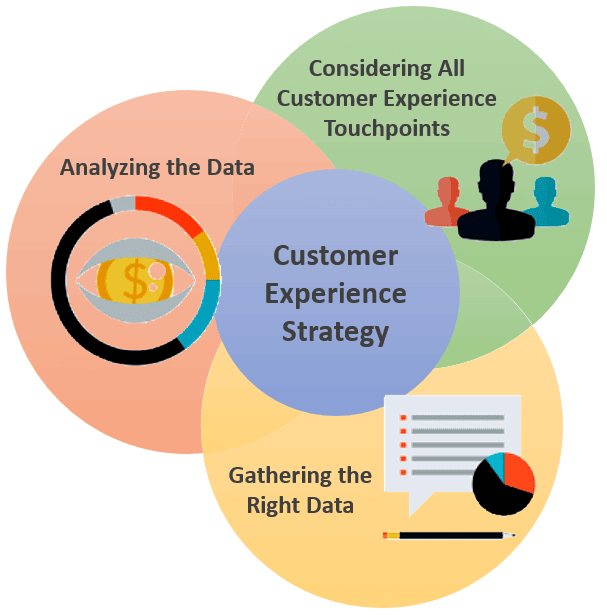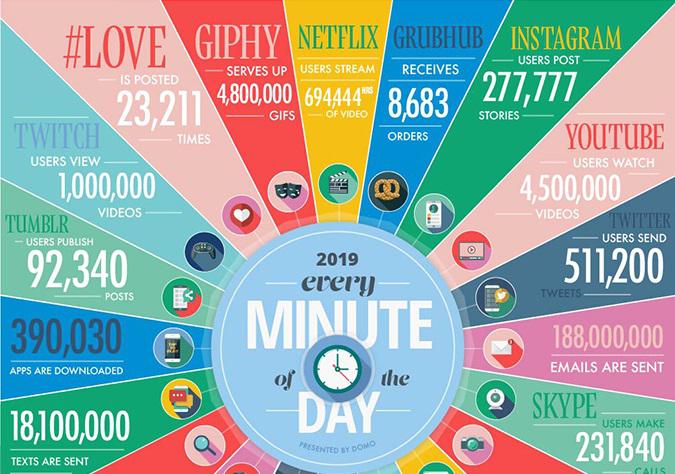In digital marketing, you can’t go far without hearing the term “big data” .
It has definitely become one of the most valuable, innovative and exciting technological offerings for the world.
In this blog, we’ll review what we really want from big data, take an in-depth look at the types of data, discuss regulatory limits on using personal information, explore how new technologies can help, and review today’s best practices for using data to enhance the customer experience.
A Brief History of Data Collection and Analysis
For well over a half a century, businesses have leveraged data about their customers to lift sales.
The practice of using targeted lists powered direct mail campaigns for decades before the World Wide Web became a household phrase in the mid-1990s.
While such campaigns occasionally prompted consumers to wonder “how did they get my name?” Still, most people resigned themselves to getting “junk mail.”
Over the past two decades, things have changed quickly and dramatically due to the interactive nature of the Internet, and there are two major facets of that change.
- Broad scope of data collection
Today, every search, voice command, and major purchase may be recorded as people go about their professional and private lives.
Often this includes communications, phone conversations, and personal emails. In the age of digital marketing, some companies now maintain profiles with thousands of datapoints about each individual.
- The establishment of customer-centrism
The well-publicized shift to customer-centrism, which requires us to do everything with the customer experience in mind.
Customer centrism has emerged as the most important concept in digital marketing.
When a direct mail marketer of yesteryear sent out 10,000 letters, the goal was to “sell” something to consumers. Now the goal is to help customer “buy” something they want by providing a satisfying customer experience.
The customer now has the ultimate control over their digital destiny. With one click, they can move away from your site and, within seconds, seek out a competitor.
While this power shift from seller to buyer was first observed in 2000, most companies have yet to truly integrate customer-centric thinking with their collection of customer data. Today’s marketers have gotten very, very good at collecting data about individuals.
But relatively few can use that data to deliver a customer experience that delights the customer. It’s little wonder that neither marketers nor consumers are entirely pleased with the outcome.
Given the vast efforts to collect consumer data, and the growing concern about the use of that data, should it be any surprise that consumers are demanding government action to protect their privacy and to prevent abuses?
In addition to the General Data Protection Regulation (GDPR) in the European Union, governments from Australia to Singapore to Russia have instituted separate and often more restrictive rules on the storage, export, or use of personal data.
Today it is challenging for companies to access a database or complete a transaction across national borders while remaining in compliance.
What marketers really want from data is to enrich the customer experience.
Yet, as a direct result of poor customer experiences, today’s marketers find themselves mired in the deep pools of data they collected—much of it isolated in technological silos— as regulations proliferate to restrict its use.
The keys to a richer digital experience hide in all this, but the solution eludes most marketers.
To truly enrich the customer experience will require marketers to step back, look at the different types of data they have.
Then they should determine the data and technologies that provide customers with the kind of experiences they expect going forward.
Key Types of Customer Data
Simply put, there’s already a lot of data and more coming our way every second. The world creates 2.5 quintillion bytes of data each day.
About 90 percent of the world’s data—since the beginning of time—has been created in just the past two years, and the pace of data-generation is skyrocketing with the growing use of devices connected to the Internet of Things.
Of course, most of that data has nothing to do with enriching customer experiences for your consumers, so we immediately see a need to focus only on the data that matters.
That raises an important question we’ll return to later: what data do you really need? The definition of marketing-related data will vary depending on whether your company is B2B, B2C, a brand, a retailer, a government agency, or something else.
But one thing is true for almost all companies: since the “big data” collection effort went into high gear around 2010, there has been a tendency to err on the side of excess.
Keep that thought in mind as we review just some of the types of customer data that marketers might access routinely.
[Data Type #1]: Transactional Data helps to understand the customers’ purchase history
For our purposes, this largely consists of records of orders, invoices, methods of payment, timing of payment, and other data associated with an event like the lease or sale of goods and services.
Obviously, this information is vital to several different teams in an organization, like accounting, merchandising, inventory, supply chain, and others.
From the marketing perspective, it can help you recognize certain customer attributes, such as the frequency of purchases and, in some cases, budgets.
Generally, this data might be collected and stored throughout the company, but marketing systems like a digital experience platform could access it through application programming interfaces (APIs).
[Data Type #2]: Behavioural Data makes it easy to know the patterns of target audiance
What people do with their devices generates records that are collected in a way that reflects their behavior.
While this may include actions a person takes with a phone, laptop, tablet, or other devices, marketers are mostly interested in tracking customers or prospects as they move through their journeys.
In personalization efforts, for example, you may want to know where visitors were just before they came to your site— whether that was a search engine, a competitor’s site, an advertisement, or somewhere else.
Savvy marketers also track a customer’s behavior on their own site. The best DXPs will use artificial intelligence (AI) and machine learning (ML) to act when certain conditions arise for the simple reason that humans alone cannot keep up with all the behavioral data being collected much less analyze it or act on that new intelligence in real time.
[Data Type #3]: Social Media Data
Social media data (or social data for short) refers to all of the raw insights and information collected from individuals social media activity – e.g. your prospects and customers.
Social media data tracks how individuals engage with your content or channels like LinkedIn, Facebook, and Twitter. It gathers numbers, percentages, and statistics from which you can infer the performance of your social media strategy.
Social media data can be used for:
- Deeper Audiance Segmentation
- Improved Lead Nurturing, Scoring, and Attribution
- Personalized Sales Outreach
- Engaging Content Experiences
There are many third-party companies that work in this area, providing services that range from monitoring different social channels for posts to sophisticated sentiment analysis tools that analyze what a social user was thinking.
[Data Type #4]: Customer Service Data provides a unique view of the customer
Your customer service representatives (CSRs) probably do a great job fielding customer feedback on your products or services.
They may also support your customer success program and sales efforts.
But do they support your marketing team well?
As consumers, most of us are used to being asked for personal information during these calls, including up-to-date phone numbers, email addresses, and street or mailing addresses.
All that fresh data could help marketing teams identify important geographic areas or send out marketing messages.
Access to CSR data files by marketing is often indirect, in part because most of the data typically lives in CRM systems.
But if there is information needed for marketing, that data can be accessed via APIs. Just make sure it stays within the bounds of regulations restricting the use of personal information.
[Data Type #5]: Inventory management Data helps to kees storage costs low and cusotmers happy
Inventory management is the act of overseeing the volume, diversity, pricing, and location of a business’s available products.
Inventory management systems generally are part of the supply chain technologies within larger companies.
While most of the data about the supply chain isn’t of immediate interest to merchandisers and marketers, some of it is vital.
For example, before a merchandiser for a retailer refers a customer to a particular product, it’s important to know if the product is in stock, on back-order, or has been canceled.
[Data Type #6]: First party data
While all the data we’ve mentioned to this point involve specific parts of the customer journey or the company’s operations, first-party data is a general term that refers to all the information that you collect directly.
In that context, it is likely to include transactional data, behavioral data, as well as other data you collect from interactions with your customers. Savvy digital marketers know this is the most crucial form of data. Yet, as we’ve noted in some of the sections above, it may be isolated in data silos around your company. Rather than duplicate that data in a marketing system, you should work with your IT group and integrators to ensure you can access the data most important to you though APIs or other connectors. If you lack access, this valuable first-party data is useless to you.
Some companies sell their first-party data directly to non-competing companies or to data vendors. Sometimes that is called “second-party data,” but to the companies that acquire it, it becomes third-party data.
[Data Type #7]: Third party data
As the name implies, third-party data includes any information generated by external sources that is gathered and sold through data exchanges. For example, public records gathered by government agencies may be compiled and sold by vendors.
Due to new regulations, the storage and use of any personal information outside of a contemporaneous customer interaction may be prohibited. So be sure to check on the regulations for your industry and region.
Where to Get Started [with best practices]
Unless you’ve done it recently, it may be time to draft some best practices to guide data-driven marketing and the technologies you use to execute those strategies. You and your team know your business best, but here are six core concepts to get you started.
- Use a pencil
No matter what seems to work today, you can bet you’ll want to make changes sooner than you think.
Flexibility is key, especially as every company in every sector—whether B2B or B2C— grapples with the best way to market to customers and prospects in the near future.
Perhaps a decade from now, the path will be clearer, but right now, you should pick technologies and practices that can adapt to whatever comes your way. If you’re ready to take advantage of it, change can help keep your company ahead of competitors. Without constant innovation, you’ll fall behind.
- Don’t go it alone
Data issues are complex. You’ll probably need help from across your organization to establish what data is available, what regulations apply, what data you’ll need, what technologies are required, and how the customer will perceive the change.
If your company doesn’t already have one, it’s a good idea to form a cross-functional council to guide change. If you’re in a big corporation that has such a team, consider creating a sub-group with a marketing focus.
At the minimum, the internal members should include someone who works hands-on with your IT systems, an accountant, a legal advisor, a senior sales manager, and the CMO or an alternate. External members should include a trusted technology advisor who is familiar with your data and marketing technologies.
B2B companies should consider adding the voice of their best customers or partners; B2C companies may want to create customer focus groups to share their input.
- Prudent regulation is your new best friend
Mark Zuckerberg befriended that concept recently in appearances before the US Congress and the European Parliament. “I think the real question, as the Internet becomes more important in people’s lives, is what is the right regulation, not whether there should be [regulation] or not,” Zuckerberg said in testimony to a joint meeting of two US Senate committees.
The company quickly rolled out GDPR-like privacy options worldwide. The reason to support regulation is twofold: first, it assures your customers you take their privacy seriously, and second, it’s probably inevitable. If yours is a global company, your policies may want to include as many international requirements as it can, simplifying your efforts to comply with the regulations throughout the world.
The alternative would be to have a different set of rules for each place you do business and/or store data—and you can see the complexity of that.
- After you review all the data your company has accumulated, determine what data you really need
Less data is more. Why? We noted earlier that companies have so much data that some IT managers either don’t know where it is or don’t know if it complies with regulations.
And if they don’t know where it is, you can bet it hasn’t been cleaned in a very, long time. So it won’t be very reliable if you try to use for marketing.
Outdated information can even offend your customers by showing you don’t really know them. To set up personalization systems on B2C sites where customers don’t sign in, you’ll really want to focus on just a few pieces of fresh data such as recent browsing history, what they’re searching for, the pages they click on, and where they are—all of which can be determine in real-time in compliance with GDPR and most other regulations.
Once you determine what data you need, consider deleting outdated or “dirty” files unless you can find a reason to keep them.
- If your data is stored in disparate systems, make sure your digital experience platform can access them all in real time
On the technical side, you may want to consider experience-led architecture that puts your DXP in the lead roles of delivering a customer experience.
In effect, that means creating a network where a modern DXP can retrieve or store data with other systems through APIs.
That will allow you to take advantage of your earlier investments in data technology while also giving you the flexibility to add or remove systems as your requirements change.
- Put your customers first
This is the very definition customer-centric marketing, yet many companies get it wrong. If you’re planning to use data you keep on your customers, ask yourself first if they’d be comfortable knowing that you even have that information.
We suggest you review your opt-in policies. Of course, customer-centricity should always be top of mind when deciding on messaging, integrating new technologies, interacting with customers during their journey, and following up on a purchase (or an abandoned cart).
Every time you interact with customers, you will gather fresh data that will help you deliver value them. So remember, your customer is the most important part of your business—not just another data point.
Summary
We began this blog discussing the flood of data pouring into your company and what it means to your customer.
We looked at the types of data used in marketing and finally some best practices for leveraging data to create an experience that is beneficial to your customer—and to you.
Now it’s your turn. Even after adopting these concepts, you’ll still be swimming in data—the age of data driven, customer-friendly marketing may be evolving rapidly, but it isn’t going to end any time soon.
However, instead of feeling like you’re overwhelmed by data, you’ll discover it will enable the sort of innovation that builds clear differentiation between you and your competitors in the eyes of your customers. Instead of drowning in data, you’ll become a world-class swimmer.
And the lead you gain over competitors will last, even after they learn what you have learned. Making up that gap will be difficult for them, giving you a long-term advantage.
At Bloomreach, we have been building technologies that enhance customer experiences through data even before “big data” was called that. We think about these topics constantly. Please let us know if we can help you review your approach to providing a digital experience that thrills your customers.















